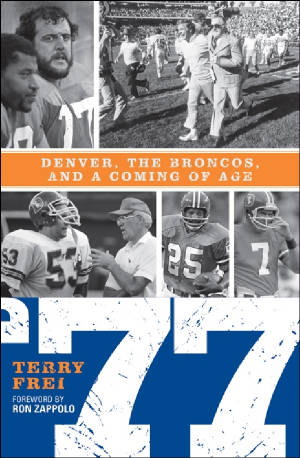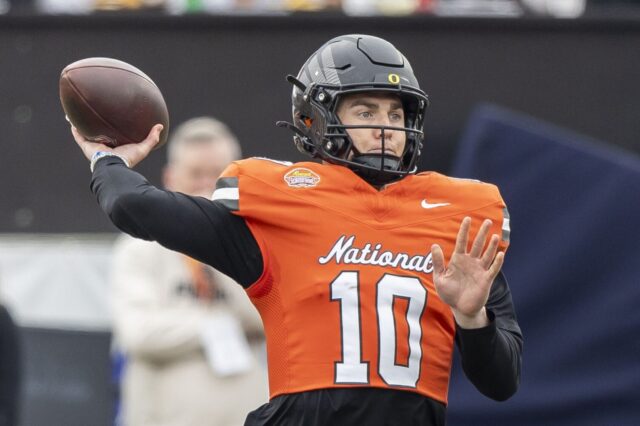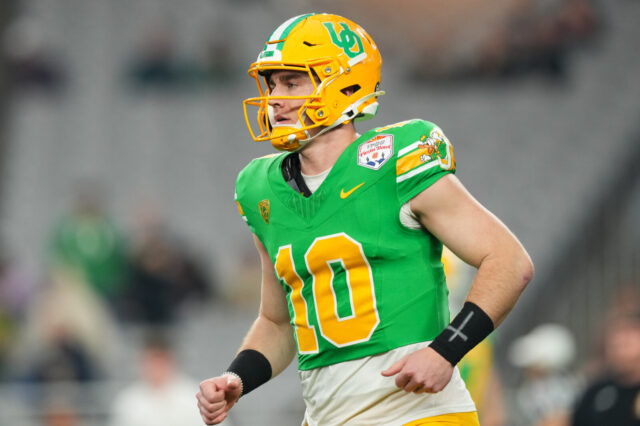
On the cover of ’77, Red Miller is running off the field with general manager Fred Gehrke after the still-famous breakthrough win at Oakland in the fifth game of the season. (Hint: Jim Turner — Ol’ Hightops! — caught a touchdown pass.)
Former Broncos coach Red Miller will be inducted into the Ring of Fame Sunday at halftime of the Denver-Cincinnati game.
Unfortunately, the honor will be posthumous. Miller died on September 27 from complications of a stroke he suffered while watching the end of the Broncos-Chargers game on September 11.
He was a central figure in my book ’77: Denver, the Broncos, and a Coming of Age, and influential in the evolution of Denver as a sports market.
It’s hard to explain the importance of that Broncos’ AFC Championship season and first Super Bowl appearance — again, its impact went far beyond football — for those who weren’t here or are unwilling to learn of a season of 40 years ago. It was about the Orange Crush of Randy Gradishar, Louis Wright and Tom Jackson; the M&M Connection of Craig Morton to Haven Moses; and the fiery first-year head coach.
It truly was transformative.
We will be posting two excerpts featuring Miller as his Ring of Fame induction approaches.
This, Part One, is Red’s story from childhood on, until he became head coach of the Broncos. (Part Two, about Red’s enmity for the &^%$# Raiders, is here.)
Red worked himself up.
That’s the only way the coal miner’s son knew how to do it.
And that’s crucial in understanding the football coach he became, and how important he became in the evolution of the Broncos — and even of this market.
New Coach, New Job
In and around Macomb, Illinois, John Samuel Miller had no tolerance for slackers, whether in the fields or under his own roof. He had left school as a young boy in nearby Colchester to work underground in the area’s coal mine, and he never learned to read and write. Yet, like many of the men who started out in the mines, he took pride that his word and his handshake were as binding and trustworthy as anything that any slick lawyer might put down on paper. He told his children — the surviving eight following the deaths in infancy of twins Billy Gene and Betty Jane — that it was the way the Millers would operate.
“As we were growing up, the biggest thing my dad gave me was the hard work ethic,” one of the sons, Robert, recalls. “He would say, ‘When you go to work and you’re going to get paid by another guy, you give them a day’s work — or you don’t take their pay.’ Hard work was his God.”
Robert, born in 1927, was the youngest of Jennie Miller’s surviving five sons. At home, he was called “Bo.” Elsewhere, he became better known as “Red.”
As he sits in his home in South Denver years later, Red calls his mother “a beautiful woman. A saint. Talk about the glue that binds.”
The family moved several times. Wherever they were, the boys jammed into one bedroom, sometimes even in one bed. The nation was in the clutches of the Great Depression. John Samuel scrambled to support his family, working as a general laborer, but also doing stints as a tenant farmer. When he could get no other jobs, he would go back to the coal mines. “He would not go on relief,” Red says.
At the dinner table, the eight children sat in order, oldest to youngest, and that’s the way the food got passed around. Red, the seventh child, knew that when the tray reached him, he needed to save half for his younger sister, Pauline, the last in line. Many times, their shares weren’t much.
The sons were expected to work and help support the family, but the thought never crossed their minds that they shouldn’t. “In my house,” Red recalls, “it was like this: ‘I respect you, you respect me, don’t ask me for money because I don’t have to give it to you. You earn what you get every day.’ That was the creed. Whatever I had, I had to work for.”
Red had paper routes at age 7, shined shoes, dig ditches, worked in restaurants, and also used his bicycle, until it was stolen, to deliver flyers that advertised businesses. When he got a little older, he got a sample of what his father had gone through.
“I worked one summer in the mines,” Red says. “It had a vein of coal about four and a half feet high, so you were working on your knees down in the coal mine every day.”
He knew he never wanted to go back.
It was a wonder that Red found time to work, given his enthusiasm for sports. In the family home’s yard, the school yard, or a vacant lot, the fame was rough tackle football. Before long, Red, at age 9, was organizing and coaching a team. Red’s team represented Macomb’s Fourth Ward, and they defended the area’s honor in informal games against the other three wards. No referee, no uniforms, no parents watching. Red was coach, general manager, promoter, organizer and — when blood flowed — trainer.
“I could name my position,” he says, “but I was always a lineman because I had too many guys who wanted to carry the ball and somebody had to do this. We gotta have a team! So I was always a lineman and linebacker.”
Always, the poor kid from the big family stood his ground. “What trouble are going to get in if it’s Macomb, Illinois, with 8,000 people at that time?” he asks. “The only troubles I had were to establish myself. I had a lot of fistfights. They call you names, like ‘red-headed woodpecker,’ but they would only call me that once because I’d challenge ’em. If they didn’t back down, we’d duke it out. What helped me was that I was tough and I wouldn’t back down to anyone.”
Along the way he also was developing his piano talents — on his own. “My dad’s people were from West Virginia, and that was bluegrass before bluegrass was born,” Red says. “My dad was a guitar picker. All of my older brothers played string instruments. When I came along, I started out on steel guitar and then went to the piano. I never have taken a lesson, I don’t know one note from the other, but I know music in my ear. I just watched and copied and we formed a band. I liked ragtime. I can’t play a million tunes, but I can play two or three in ragtime.”
His first formal sports team was at Edison Junior High, and he arranged his jobs around basketball practice. There, he already showed the talent that stamped him as one of the town’s top athletes. The United States was in World War II, and his oldest brother, Leonard, went into the Army and eventually survived the Battle of the Bulge. Young Red followed the news on the radio and in the papers.
After the war ended, Leonard returned home and became a second father for Red, moving back in to the family home, opening a cement block plant with brother Glade in Macomb, and hiring his own father as one of the truck drivers.
“He couldn’t get a license because he couldn’t read the test,” Red says. “There was an Illinois state senator who lived in our town, I can’t remember his name, and he said, ‘John, come into my office and if you can tell me what these signs are by eyeing them, OK.’ And my dad did that. He knew the shape of a stop sign, slow, yield, all the signs. So he got a truck driver’s license that way.”
As a senior at Macomb High in 1945-46, Red was an all-state football player and the homecoming king. In what passed for a recruiting blitz at the time, it came down to Red choosing among three colleges — Purdue, Kent State, and the hometown Western Illinois State Teachers College. The Purdue offer came from the owner of a bookstore in Macomb, who said if Red went to Purdue and played football, he would pay all of his college costs and expenses. (That sort of private offer from a booster was typical at the time and certainly not untoward or illegal.)
Red didn’t visit Purdue, but he did take the train to Kansas State. He didn’t want to leave his parents — or, mostly, his beloved mother — and Western Illinois came through with an offer of $17.50 per quarter for tuition. Plus, he had gone to Western Illinois games as a kid and dreamed of paying for the hometown team. “I didn’t have any money, so I sneaked in there,” he says. “I remember the homecoming parades, too. They marched around the square and all the way to the edge of town. I followed their band all the way out to where they stopped playing and disbanded.”
He decided to stay home — cutting costs by continuing to live with his parents and his oldest brother, Leonard.
“I chose to be a big boy in a little pond and it was the right choice for me,” Red says.
His parents had never gone to any of his high school games. His mother couldn’t drive drive and his father didn’t understand why there was all this fuss about sports. When Red told his dad he had gotten a scholarship to go to college and play football, John Miller responded, “What’s the matter with you, boy? You need to get a job.” With encouragement from his brother and mother, Red decided to go to college, anyway.
He started right away, as a freshman, for the Leathernecks football team, playing as a guard and linebacker. Then, as a boxer, he went to the regional Golden Gloves. “I lost my first fight,” he says. “That was in the winter and I dropped out of school immediately. I thought it was such a disgrace.”
In disgust, he went to work full-time at his brother’s cement block plant. “All I did was load and unload blocks all day long, every day,” he says. “I think I made $40 a week, $1 an hour. That was a lot of money for me back then. Boy, I was in shape, though.”
He went back to school in the fall and went on to be the Leathernecks’ MVP the next three seasons, the Illinois Intercollegiate Athletic Conference MVP as a sophomore, and both team captain and campus homecoming king as a senior. He also avenged his boxing loss by becoming regional Golden Gloves heavyweight champion before giving up that sport. He picked up some spare change forming a band and playing piano. “We were Red Miller and his Three Plus Two, and we played for a couple of proms,” he says. “We got $5 each.”
Later in his college career, he landed a coveted job working as the late-shift bartender at the local Elks Club. While going to school, his official hours were from 4 p.m. to midnight, but they often ran much longer.
“There were no slot machines or gambling allowed in Macomb — except in the Elks Club,” Red says.
The club also had two poker tables. After the club was officially closed, Red would stay behind the bar and keep serving as long as the players tipped him a dollar an hour. It was a good deal for everyone — well, at least for the winners, who often tipped more — but it made for long nights and little sleep for the college student behind the bar.
Even after his final college football game, a 13-0 Western Illinois win over Wheaton in the Corn Bowl following the ’49 season, Red hurried back to Macomb to be able to work at the Elks Club’s big dance.
He knew he wanted to be a coach. In fact, he had known it for a long time, even telling a high school counselor he wanted to be a coach in the National Football League. “He kind of snickered a little bit,” Red recalls.
In the postwar years, many young men — some wartime veterans, some not — were hitting the job market at the same time, and coaching was one of the fields that didn’t expand quickly. So despite his playing credentials, a diploma and a transcript that showed a major in physical education and minors in journalist (!) and biology, Red didn’t land a coaching job right away. For nearly a year after leaving Western Illinois, he continued to work at the Elks Club and wondered what it would take to break into coaching and start proving his counselor wrong.
He visited legendary Western Illinois athletic director Ray “Rock” Hanson, who had served as the school’s football coach between the two world wars. As a Marine in World War I, he earned the Navy Cross, a Silver Star, and a French Croix de Guerre. Honoring that service, Congress gave permission for the program coached by the former Marine to adopt the Fighting Leathernecks nickname and the Marines seal and emblems. Hanson re-entered the Marines during World War II, and when he returned to the campus, he gave up coaching and became the AD only.
Hanson suggested that Red keep his job at the Elks, but help coach the Leathernecks’ new junior varsity team. After a year, Hanson told Red he had lined up two job interviews for him.
“I drove up to a little town by Peoria,” Miller says, “and I didn’t get that job.”
Next, he went to tiny Astoria, Illinois, about 24 miles from Macomb. The high school had 90 students and the coaching job had three candidates. “Lo and behold,” Red says, “they called me back and offered me the job.”
His annual salary was $2,700. He started in the fall of 1951, when he was 23.
“Now you won’t believe this,” he says, “but I taught three biology courses plus four PE courses each day. I was head football coach, head track coach, assistant basketball coach, and I ran my own boxing program. I loved it.”
For his first year, he rented a room in a boarding house and then married his Macomb girlfriend, Nancy. Red moved on to Canton (Illinois) High School in 1953, and that’s where their son, Steve, was born. Next, Red heard from the man he came to consider his mentor Carthage College Coach Art Keller.
“When he called me, I was really happy,” Red recalls. “He was 30 miles from my hometown and he knew me because I was the best football player around there and now I’m a high school coach.”
In 1954, Miller signed on as the line coach and track coach. Years later, he still calls Keller “the best, most intelligent football coach I’ve ever worked with or been around.”
He asks, “You know how many coaches we had? Two. You know who did all the athletic training and taping? Me. You know how we got to the games? We drove cars.”
Miller liked taking players to the games because he got a mileage allowance that helped out the family finances. One week, Keller an Miller were among the five drivers taking the team to Eureka College — the alma mater of actor Ronald Reagan — for what the Carthage coaches believed was a Friday night game.
At the campus, Miller spotted a night watchman and asked how to get into the stadium and the visiting team dressing room.
The watchman gave Miller a quizzical look.
“Coach,” he said, “you don’t play until tomorrow.”
Such were the pitfalls of small-college football in those days.
“We drove home, came back the next day, kicked their ass and went back home,” Red says, smiling.
During Red’s stay at Carthage, his second child, Lana, was born.
In early 1957, Miller got a phone call from Dr. Frank Beu, the president of Western Illinois, who was looking for a coach to succeed Wes Stevens. Red’s name had been tossed into the mix, but he wasn’t yet 30. Beu said he would be driving through Carthage that afternoon and asked if h could have about a half hour of Miller’s time.
When he arrived, he put a strange offer on the table. The ex-Marine Hanson still was the athletic director, but he was clearly winding down his career, and Beu took the lead in the coaching search.
“He says to me, ‘Red, you were a hell of a player and a hell of a leader for us, and I’d love to have you as head coach, but I don’t think you’re ready yet.'”
Next Beu said he was considering about 20 other candidates, handed Miller a list and asked what he thought. One name jumped out. Lou Saban had been a star at Indiana and in the All-American Football Conference. He had moved up from an assistant’s role to be the head coach at Northwestern in 1955, and that single 0-8-1 season was in a holding pattern before Ara Parseghian — as planned — took over for ’56. But Saban’s name still was familiar and he certainly looked qualified on paper, and to a young Red Miller. So that’s what he told Beu.
Beu also said he was going to keep asking around and interviewing, but he hired Miller on the spot as the new coach’s (whoever that was) offensive and defensive line coach.
Saban got the head coaching job, and Miller’s Western Illinois contract didn’t start until the fall, so he had to coach in spring practice as a volunteer and continue to coach at Carthage. “I told Keller, and he was great about it,” Red says. “He said, ‘Take off as soon as you’re done with your last class and get your rear end up there every day.'”
The Leathernecks also hired a young coach, former Northwestern end Joe Collier, as an assistant. For three years, Saban, Collier and Miller guided the Leathernecks to records of 5-4, 6-1-1 and 9-0, winning the last 15 in a row. Miller also taught golf and archery classes, and after Hanson heard he once had been a lifeguard, he informed Red he now was the school’s swimming coach. “I couldn’t believe it,” he says. “I’d never been around competitive swimming. I bought a book and I did all right.”
After the undefeated ’59 season, Miller and Collier were doing paperwork when Saban asked them to come into his office. With the door closed, he told them he was talking with the ownership of the Boston franchise in the American Football League, which would begin play in the 1960 season. If he got the job, Saban said, he would want to take Miller and Collier with him and he wanted to know if they were interested.
Sure, they said.
A few days later, Saban was the head coach of the Boston Patriots and offered jobs to his college assistants. But Miller also was offered the chance to be Saban’s successor at Western Illinois. His alma mater. His hometown. Head coach!
Finally, he thought of his goal — to make the NFL — and he decided that he should take the chance to get to the pro game, albeit in the “new” league. So he and his family were headed to the East Coast. Miller caught a flight to Boston and picked out a home.
It was his first time on an airplane.
At times, Miller wondered if going to the AFL was a smart career move. With the new league’s 33-man rosters for 1960, Miller was an offensive line coach with his starters and only a couple of guys to back them up. The Patriots had horrible practice facilities at Boston University and also played there. Losing their final four games, the Patriots finished 5-9 in their inaugural year. In the second season, 1961, despite the addition of quarterback Babe Parilli, Saban was fired after a 2-3 start and player personnel head Mike Holovak became head coach. Holovak wanted to retain both Miller and Collier, and even told Miller he could run the offense. (The title “coordinator” was just coming into common use.) Saban got the job at Buffalo for the 1962 season and recruited his former Western Illinois coaches to rejoin him. “I decided to go because I liked working under Lou better than I would like coaching under Holovak,” Miller says.
The Bills lost their first five, but got righted. When the Bills also claimed quarterback Jack Kemp on waivers from San Diego, that also helped considerably. So Buffalo seemed on the move, and Saban immediately assured Miller he would add the offensive coordinator title. By then, that sort of title was becoming more important for resume purposes, and Miller already was looking ahead to trying to move up. When Saban introduced him at a postseason rally as the offensive line coach and Miller asked about the promised offensive coordinator title, Saban informed him that, at least officially, his title wouldn’t change.
“I knew then I was going elsewhere,” Red says.
Having no idea what he would do next, Miller quit. The next day, Denver Broncos coach Jack Faulkner called and offered Red a two-year contract — unusual for assistant coaches, who usually had one-year deals. Red and his family came to the Rockies, and Miller at times felt as if he were back in the inaugural year of the AFL. The Broncos weren’t a complete joke — just close to it. The Broncos’ infamous and hideous brown and yellow uniforms were in the past, but the team’s practice facilities adjacent to Mile High Stadium were ramshackle, as the original ownership was in the process of selling the team to the Phipps Brothers, Allan and Gerald.
Miller laughs when remembering the practice field. “The offices were in a Quonset hut, so every time I stood up, I hit my head on the curved ceiling,” he says.
He stayed three seasons, through 1965, working under Faulkner and then — after Faulkner was fired — for Mac Speedie. The Broncos won only eight games in the three years, and although the franchise was moving toward credibility under the Phipps brothers, Red jumped at the chance to move to the NFL, joining the St. Louis Cardinals for the 1966 season. Driving to St. Louis for the first time in his new cherry-red Mustang, he thought: “I’ve finally made it I’m going to the NFL!”
At St. Louis, he again was working for a team owned by brothers — Bill and “Stormy” Bidwill. Stormy has a rogue’s charm to him, but Bill’s penurious ways were aggravating, and in retrospect, it seems amazing that the Cardinals were as competitive as they were.
All five of Miller’s starting offensive linemen — Bob DeMarco, Irv Goode, Ken Gray, Ernie McMillan and Bob Reynolds — were selected for the Pro Bowl during his five-season run. Theirs was the strongest link in an otherwise frequently weak chain, and Miller stayed through the 1970 season before moving on to the Baltimore Colts, who had just won the Super Bowl under Don McCafferty. Eventually, the staff got word that the owner, Carroll Rosenbloom, had traded franchises and acquired the Los Angeles Rams, and that air conditioning magnate Robert Irsay was buying the Colts. He rubbed the coaches and players the wrong way from his first meeting with the team, and Miller wasn’t shocked when the entire staff was fired after the 1972 season.
By then, Red had a solid reputation as an offensive line coach, but there weren’t many coaching changes that off-season, and he was starting to worry when he got an offer from former Oklahoma coach Chuck Fairbanks, who was taking over the New England Patriots. Fairbanks was a defensive-minded coach who was astute enough to turn the offense over to an experienced, reliable hand, as he had done with the Sooners. So, as Miller remembers it, Fairbanks told him: “You coach the offense, you write the playbook, you use your terminology, you call every play, and I will never second-guess you.”
How did that turn out?
Fairbanks later became a bit of a Colorado joke punch line — that is, “Who coached Colorado to two consecutive losses to Drake?” — but any attempt to get Miller to say anything negative about the taciturn coach will fail. Miller was in charge not only of an offensive line that included standouts John Hannah, Leon Gray and Sam Adams, but he was running the offense — and becoming a bit restless. Miller felt he was ready to be a head coach in the NFL.
His final game with the Patriots, as it turned out, was a controversial 24-21 loss to the Oakland Raiders in the 1976 postseason. That game lives in infamy because of a phantom roughing-the-passer penalty on the Patriots’ Ray “Sugar Bear” Hamilton that kept the Raiders alive. The referee was the caustic Ben Dreith, ironically a long-time Denver resident, and it’s arguable that the call cost the Patriots a Super Bowl championship, since the Raiders went on to easily win both the AFC championship game over Pittsburgh and the Super Bowl over Minnesota. Some Patriots fans didn’t get over that call until New England’s Super Bowl victory over St. Louis after the 2001 season. And some of them still haven’t gotten over it. Neither has Red.
After the season, Miller told Fairbanks he felt he had done all he could do as a Patriots assistant — and as an assistant, period — and was going to keep his ears open more than ever before for other possibilities. Fairbanks gave him his blessing.
On about January 20, when Denver general manager Fred Gehrke broached the possibility of Miller returning to the Broncos to be John Ralston’s offensive coordinator, Miller had a succinct answer.
“No,” he told Gehrke. “No more lateral moves.”
Miller’s phone rang after he had come home from church on January 30. As he remembers it, the caller was Gerald Phipps.
“I know you turned us down as an offensive coordinator,” Phipps said, “but how would you like to be head coach?”
Miller recalls that he was “so excited, it was unbelievable.” He says he thought to himself: Does a bear —- in the woods?
Red Miller, at age 49, was the head coach of the Denver Broncos.
The year was ’77.
In tomorrow’s Part 2: How Miller quickly let his new players know how much he hated the %$#@& Oakland Raiders … and set out to do something about it.
* * *
Denver-based journalist Terry Frei writes commentaries about the Avalanche for Mile High Sports. He has been named a state’s sports writer of the year seven times, four times in Colorado (including for 2016) and three times in Oregon. He’s the author of seven books, including the fact-based novel “Olympic Affair” about Colorado’s Glenn Morris, the 1936 Olympic decathlon champion; and “Third Down and a War to Go,” about the 1942 football national champion Wisconsin Badgers and the players’ subsequent World War II heroism. His web site is terryfrei.com and his additional “On the Colorado Scene” commentaries are at terryfrei/oncolorado.
E-mail: [email protected]
Twitter: @tfrei




